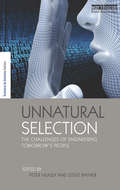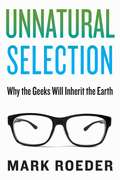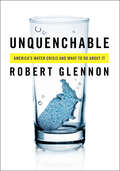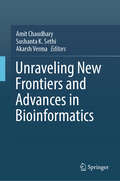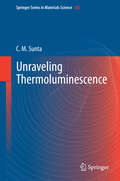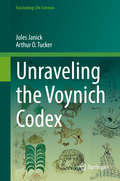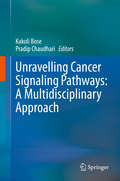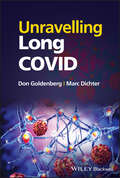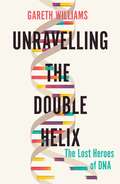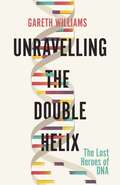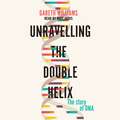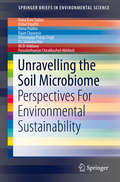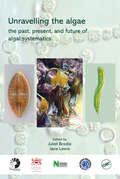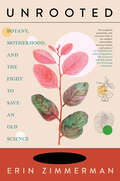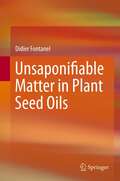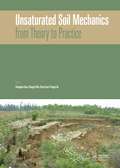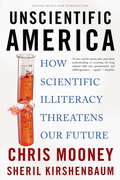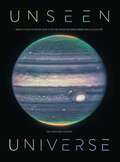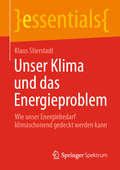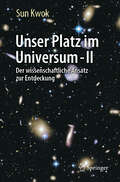- Table View
- List View
Unnatural Selection: The Challenges of Engineering Tomorrow's People (The Earthscan Science in Society Series)
by Steve Rayner Peter HealeyWith ever-advancing scientific understanding and technological capabilities, humanity stands on the brink of the potential next stage of evolution: evolution engineered by us. Nanotechnology, biotechnology, information technology and cognitive science offer the possibility to enhance human performance, lengthen life-span and reshape our inherited physical, cognitive and emotional identities. But with this promise come huge risks, complex choices and fundamental ethical questions: about evolution; about what it is to be human; and about control over, and the distribution of benefits from, new technology. Written by a range of experts in science, technology, bioethics and social science, Unnatural Selection examines the range of technological innovations offering lives that purport to be longer, stronger, smarter and happier, and asks whether their introduction is likely to lead to more fulfilled individuals and a fairer world. The breadth of approaches and perspectives make important reading for anyone who cares about the implications of humanity engineering its own evolution.
Unnatural Selection: Why the Geeks Will Inherit the Earth
by Mark RoederUnnatural Selection is the first book to examine the rise of the "technocentric being"-or geek-who personifies a distinct new phase in human evolution. People considered geeks often have behavioral or genetic traits that were previously considered detrimental. But the new environment of the Anthropocene period-the Age of Man-has created a kind of digital greenhouse that actually favors their traits, enabling many non-neurotypical people to bloom. They resonate with the technological Zeitgeist in a way that turns their weaknesses into strengths. Think of Mark Zuckerberg versus the towering, Olympics-bound Winklevoss twins in the movie Social Network.Roeder suggests that the rise of the geek is not so much the product of Darwinian "natural selection" as of man-made-or unnatural-selection. He explains why geeks have become so phenomenally successful in such a short time and why the process will further accelerate, driven by breakthroughs in genetic engineering, neuropharmacology, and artificial intelligence. His book offers a fascinating synthesis of the latest trends in these fields and predicts a twenty-first century "cognitive arms race" in which new technology will enable everyone to become more intelligent and "geek-like."
Unquenchable: America's Water Crisis and What To Do About It
by Robert Jerome GlennonIn the middle of the Mojave Desert, Las Vegas casinos use billions of gallons of water for fountains, pirate lagoons, wave machines, and indoor canals. Meanwhile, the town of Orme, Tennessee, must truck in water from Alabama because it has literally run out. Robert Glennon captures the irony--and tragedy--of America's water crisis in a book that is both frightening and wickedly comical. From manufactured snow for tourists in Atlanta to trillions of gallons of water flushed down the toilet each year, Unquenchable reveals the heady extravagances and everyday inefficiencies that are sucking the nation dry. The looming catastrophe remains hidden as government diverts supplies from one area to another to keep water flowing from the tap. But sooner rather than later, the shell game has to end. And when it does, shortages will threaten not only the environment, but every aspect of American life: we face shuttered power plants and jobless workers, decimated fi sheries and contaminated drinking water. We can't engineer our way out of the problem, either with traditional fixes or zany schemes to tow icebergs from Alaska. In fact, new demands for water, particularly the enormous supply needed for ethanol and energy production, will only worsen the crisis. America must make hard choices--and Glennon's answers are fittingly provocative. He proposes market-based solutions that value water as both a commodity and a fundamental human right. One truth runs throughout Unquenchable: only when we recognize water's worth will we begin to conserve it.
Unraveling New Frontiers and Advances in Bioinformatics
by Akarsh Verma Sushanta K. Sethi Amit ChaudharyThis book describes the bioinformatics research field, from its historical roots to the cutting-edge technologies. Many readers can discover the power of next-generation sequencing and genomic data analysis, uncover the secrets of single-cell genomics and transcriptomics, explore the metagenomics and microbiome analysis, and predict the protein structures using structural bioinformatics. Several case studies witnessing the fusion of bioinformatics and artificial intelligence, driving insights from vast biological datasets have also been explored. Other important aspects listed in the book are integrating the omics data for a holistic view of biological systems; experiencing the future of medicine with precision healthcare and personalized treatments; accelerating drug discovery and repurposing through computational approaches; agricultural genomics; and exploring the role of immunoinformatics in designing effective vaccines against infectious diseases.
Unraveling Thermoluminescence
by C M SuntaThe book is essentially about the theoretical aspects of thermoluminescence (TL). It is structured and written in a manner which will specially be of interest to the fresh undergraduate students and young researchers planning to take up work in the field of thermoluminescence. It is arranged into seven chapters, starting with the historical growth of the subject of TL and an overview of the luminescence phenomena. A Physical model involving thermally disconnected deep traps is specially described. Using this model expressions are derived for the TL intensity growth curve, the supralinearity factor and the pre-dose sensitization factor. A new factor, called the sensitization factor is introduced which co-relates the supralinearity and the pre-dose sensitization factors. Dealing with the theoretical models of TL, limitations of the general order (GO) kinetics and the mixed order kinetics models are specially brought out. Due to the lacunae of GO model the determination of activation energy becomes subject to error, when GO model is applied to the experimental TL glow curves. Satisfying the quasi-equilibrium (QE) condition is essential for the validity of analytical models of TL. A new method is given to ascertain if QE condition is satisfied in an experimental glow curve. The book assumes a basic knowledge of physics and mathematics at an undergraduate level and takes the reader to the results at the cutting edge of understanding of the subject in an easy to understand manner.
Unraveling the Voynich Codex (Fascinating Life Sciences)
by Jules Janick Arthur O. TuckerUnraveling the Voynich Codex reviews the historical, botanical, zoological, and iconographic evidence related to the Voynich Codex, one of the most enigmatic historic texts of all time. The bizarre Voynich Codex has often been referred to as the most mysterious book in the world. Discovered in an Italian Catholic college in 1912 by a Polish book dealer Wilfrid Voynich, it was eventually bequeathed to the Beinecke Rare Book and Manuscript Library of Yale University. It contains symbolic language that has defied translation by eminent cryptologists. The codex is encyclopedic in scope and contains sections known as herbal, pharmaceutical, balenological (nude nymphs bathing in pools), astrological, cosmological and a final section of text that may be prescriptions but could be poetry or incantations. Because the vellum has been carbon dated to the early 15th century and the manuscript was known to be in the collection of Emperor Rudolf II of the Holy Roman Empire sometime between 1607 and 1622, current dogma had assumed it a European manuscript of the 15th century. However, based on identification of New World plants, animals, a mineral, as well as cities and volcanos of Central Mexico, the authors of this book reveal that the codex is clearly a document of colonial New Spain. Furthermore, the illustrator and author are identified as native to Mesoamerica based on a name and ligated initials in the first botanical illustration. This breakthrough in Voynich studies indicates that the failure to decipher the manuscript has been the result of a basic misinterpretation of its origin in time and place. Tentative assignment of the Voynichese symbols also provides a key to decipherment based on Mesoamerican languages. A document from this time, free from filter or censor from either Spanish or Inquisitorial authorities has major importance in our understanding of life in 16th century Mexico. Publisher's Note: For the eBook editions, Voynichese symbols are only rendered properly in the PDF format.
Unravelling Cancer Signaling Pathways: A Multidisciplinary Approach
by Kakoli Bose Pradip ChaudhariUnravelling the intricate cell signalling networks and their significance in cancer poses major intellectual challenge. Keeping this in mind, the book aims at understanding the mechanism of action of different proteins and their complexes in the cancer signalling pathways. Hence, the proposed book that comprises 20 chapters provides a comprehensive introduction on cell signalling, its alterations in cancer, molecules that have been popular targets as well as the ones that are emerging as targets. In addition, it discusses different forms of therapy that are coming up for its treatment. Other than that, a major portion of the book is focused on studying different disciplines at the interface of biology and other areas of science that are being used to understand cancer biology in depth.
Unravelling Long COVID
by Marc Dichter Don GoldenbergUnravelling Long COVID An authoritative medical reference on the various ways in which Long-COVID presents and an in-depth discussion of its mechanisms and potential therapeutic options. Unravelling Long COVID aims to provide a better awareness and understanding of the persistent health problems that can arise following SARS-CoV-2 infection. Variously described as Long-COVID, Long-Haulers’ Syndrome, and Post-Acute Sequelae of SARS-CoV-2, this newly-designated disorder is estimated to have affected somewhere between 50 to 250 million people. It is in fact considered by many as the next global public health disaster. With such a broad and important topic, the authors of Unravelling Long COVID have focused primarily on two major problems in the current understanding of Long-COVID: 1.) the failure to distinguish patients with organ damage—here called Long-COVID Disease – and those with unexplained, persistent symptoms—what is termed Long-COVID syndrome, and 2.) the failure of current medical approaches to comprehend and treat those persistent unexplained symptoms. Unravelling Long COVID is: One of the first books focused specifically on defining and understanding Long-COVID with the goal of establishing optimal management A unique reference to distinguish patients with organ damage caused by Long-COVID disease from those with unexplained, persistent symptoms that manifest as Long-COVID syndrome An in-depth exploration of neuroimmune pathways to help clarify the previously unexplained symptoms of Long-COVID Unravelling Long COVID is an essential reference for anyone interested in Long-COVID and the impact that this condition has had on the population. It will be a useful resource for both patients suffering from the Long-Covid syndrome, their physicians and for the growing number of Long-COVID clinics that have been established across the US, the UK, and other countries.
Unravelling the Double Helix: The Lost Heroes Of Dna
by Gareth WilliamsAn insightful history of the first hundred years of DNA, Unraveling The Double Helix tells the story one of the greatest triumphs of modern science. Unraveling the Double Helix covers the most colorful period in the history of DNA, from the discovery of "nuclein" in the late 1860s to the publication of James Watson's The Double Helix in 1968. These hundred years included the establishment of the Nobel Prize, antibiotics, x-ray crystallography, the atom bomb and two devastating world wars—events which are strung along the thread of DNA like beads on a necklace. The story of DNA is a saga packed with awful mistakes as well as brilliant science, with a wonderful cast of heroes and villains. Surprisingly, much of it is unfamiliar. The elucidation of the double helix was one of the most brilliant gems of twentieth century science, but some of the scientists who paved the way have been airbrushed out of history. James Watson and Francis Crick solved a magnificent mystery, but Gareth Williams shows that their contribution was the last few pieces of a gigantic jigsaw puzzle assembled over several decades. The book is comprehensive in scope, covering the first century of the history of DNA in its entirety, including the eight decades that have been neglected by other authors. It also explores the personalities of the main players, the impact of their entanglement with DNA, and what unique qualities make great scientists tick.
Unravelling the Double Helix: The Lost Heroes of DNA
by Gareth WilliamsDNA. The double helix; the blueprint of life; and, during the early 1950s, a baffling enigma that could win a Nobel Prize. Everyone knows that James Watson and Francis Crick discovered the double helix. In fact, they clicked into place the last piece of a huge jigsaw puzzle that other researchers had assembled over decades. Researchers like Maurice Wilkins (the 'Third Man of DNA') and Rosalind Franklin, famously demonised by Watson. Not forgetting the 'lost heroes' who fought to prove that DNA is the stuff of genes, only to be airbrushed out of history. In Unravelling the Double Helix, Professor Gareth Williams sets the record straight. He tells the story of DNA in the round, from its discovery in pus-soaked bandages in 1868 to the aftermath of Watson's best-seller The Double Helix a century later. You don't need to be a scientist to enjoy this book. It's a page-turner that unfolds like a detective story, with suspense, false leads and treachery, and a fabulous cast of noble heroes and back-stabbing villains. But beware: some of the science is dreadful, and the heroes and villains may not be the ones you expect.
Unravelling the Double Helix: The Lost Heroes of DNA
by Gareth WilliamsDNA. The double helix; the blueprint of life; and, during the early 1950s, a baffling enigma that could win a Nobel Prize. Everyone knows that James Watson and Francis Crick discovered the double helix. In fact, they clicked into place the last piece of a huge jigsaw puzzle that other researchers had assembled over decades. Researchers like Maurice Wilkins (the 'Third Man of DNA') and Rosalind Franklin, famously demonised by Watson. Not forgetting the 'lost heroes' who fought to prove that DNA is the stuff of genes, only to be airbrushed out of history. In Unravelling the Double Helix, Professor Gareth Williams sets the record straight. He tells the story of DNA in the round, from its discovery in pus-soaked bandages in 1868 to the aftermath of Watson's best-seller The Double Helix a century later. You don't need to be a scientist to enjoy this book. It's a page-turner that unfolds like a detective story, with suspense, false leads and treachery, and a fabulous cast of noble heroes and back-stabbing villains. But beware: some of the science is dreadful, and the heroes and villains may not be the ones you expect.
Unravelling the Double Helix: The Lost Heroes of DNA
by Gareth WilliamsDNA. The double helix; the blueprint of life; and, during the early 1950s, a baffling enigma that could win a Nobel Prize. Everyone knows that James Watson and Francis Crick discovered the double helix. In fact, they clicked into place the last piece of a huge jigsaw puzzle that other researchers had assembled over decades. Researchers like Maurice Wilkins (the 'Third Man of DNA') and Rosalind Franklin, famously demonised by Watson. Not forgetting the 'lost heroes' who fought to prove that DNA is the stuff of genes, only to be airbrushed out of history. In Unravelling the Double Helix, Professor Gareth Williams sets the record straight. He tells the story of DNA in the round, from its discovery in pus-soaked bandages in 1868 to the aftermath of Watson's best-seller The Double Helix a century later. You don't need to be a scientist to enjoy this book. It's a page-turner that unfolds like a detective story, with suspense, false leads and treachery, and a fabulous cast of noble heroes and back-stabbing villains. But beware: some of the science is dreadful, and the heroes and villains may not be the ones you expect.
Unravelling the Soil Microbiome: Perspectives For Environmental Sustainability (SpringerBriefs in Environmental Science)
by Dhananjaya Pratap Singh Ratna Prabha Purushothaman Chirakkuzhyil Abhilash Rama Kant Dubey Vishal Tripathi Rajan Chaurasia Ch. Srinivasa Rao Ali El-KeblawyThis book explores the significance of soil microbial diversity to understand its utility in soil functions, ecosystem services, environmental sustainability, and achieving the sustainable development goals. With a focus on agriculture and environment, the book highlights the importance of the microbial world by providing state-of-the-art technologies for examining the structural and functional attributes of soil microbial diversity for applications in healthcare, industrial biotechnology, and bioremediation studies. In seven chapters, the book will act as a primer for students, environmental biotechnologists, microbial ecologists, plant scientists, and agricultural microbiologists. Chapter 1 introduces readers to the soil microbiome, and chapter 2 discusses the below ground microbial world. Chapter 3 addresses various methods for exploring microbial diversity, chapter 4 discusses the genomics methods, chapter 5 provides the metaproteomics and metatranscriptomics approaches and chapter 6 details the bioinformatics tools for soil microbial community analysis, and chapter 7 concludes the text with future perspectives on further soil microbial uses and applications.
Unravelling the algae: the past, present, and future of algal systematics
by Jane Lewis Juliet BrodieActing as titans in global control of the biosphere and colonizing virtually all corners of the earth, algae, extremely diverse and numerous oxygenic, photosynthetic organisms, can be major players in and drivers of environmental change. For hundreds of years, since their evolutionary origins by endosymbiosis, when a protozoan enslaved a cyanobacte
Unrooted: Botany, Motherhood, and the Fight to Save an Old Science
by Erin Zimmerman"Evolutionary botanist Zimmerman discusses her passion for plants and inveighs against sexism in the sciences in her marvelous debut memoir...Throughout, Zimmerman&’s enthusiasm and expertise make the science accessible even to those without a background in the subject. The results are as edifying as they are galvanizing." - Publishers Weekly STARRED Review"Erin Zimmerman has exposed a rooted gender failure in science. Her book is important not for this alone. Her work is essential for understanding the future resilience of all flora on this planet." -Diana Beresford-Kroeger, author of To Speak for the TreesAn exploration of science, motherhood, and academia, and a stirring account of a woman at a personal and professional crossroads . . .Growing up in rural Ontario, Erin Zimmerman became fascinated with plants—an obsession that led to a life in academia as a professional botanist. But as her career choices narrowed in the face of failing institutions and subtle, but ubiquitous, sexism, Zimmerman began to doubt herself.Unrooted: Botany, Motherhood, and the Fight to Save an Old Science is a scientist&’s memoir, a glimpse into the ordinary life of someone in a fascinating field. This is a memoir about plants, about looking at the world with wonder, and about what it means to be a woman in academia—an environment that pushes out mothers and those with any outside responsibilities. Zimmerman delves into her experiences as a new mom, her decision to leave her position in post-graduate research, and how she found a new way to stay in the field she loves.She also explores botany as a &“dying science&” worth fighting for. While still an undergrad, Zimmerman&’s university started the process of closing the Botany Department, a sign of waning funding for her beloved science. Still, she argues for its continuation, not only because we have at least 100,000 plant species yet to be discovered, but because an understanding of botany is crucial in the fight against climate change and biodiversity loss.Zimmerman is also a botanical illustrator and will provide 8 original illustrations for the book.
Unsaponifiable Matter in Plant Seed Oils
by Didier FontanelHere, the author has compiled data on about 550 oil-bearing plant species with respect to their content of unsaponifiable matters and oils. This unique information resource offers important information for research and development of food products such as neutraceuticals as well as cosmetics. Unsaponifiable matters have varying effects: Conservation and stability (e.g. lignans, tocopherols, tocotrienols), anti-inflammatory properties (triterpene alcohols), cholesterol-lowering (sterols), well tolerated occlusive effect on the skin (squalene). Information is provided in a clear and systematic fashion, including data on relevant chemical families and pertinent chemical structures. Also included is a thesaurus of English, Latin and French plant species names as well as 655 references to the scientific literature.
Unsaturated Soil Mechanics - from Theory to Practice: Proceedings of the 6th Asia Pacific Conference on Unsaturated Soils (Guilin, China, 23-26 October 2015)
by Changfu Wei Zhenghan Chen De’an Sun Yongfu XuIn the past decades advances have been made in the research and practice on unsaturated soil mechanics. In 2000 the first Asia-Pacific Conferences on Unsaturated Soils was organized in Singapore. Since then, four conferences have been held under the continued support of the Technical Committee on Unsaturated Soils (TC106) of the International Socie
Unscientific America: How Scientific Illiteracy Threatens our Future
by Chris Mooney Sheril KirshenbaumClimate change, the energy crisis, nuclear proliferation-many of the most urgent problems of the twenty-first century require scientific solutions, yet America is paying less and less attention to scientists. For every five hours of cable news, less than one minute is devoted to science, and the number of newspapers with science sections has shrunk from ninety-five to thirty-three in the last twenty years. In Unscientific America, journalist and best-selling author Chris Mooney and scientist Sheril Kirshenbaum explain this dangerous state of affairs, proposing a broad array of initiatives that could reverse the current trend.An impassioned call to arms, Unscientific America exhorts Americans to reintegrate science into public discourse-before it is too late.
Unscrewed: Salvage and Reuse Motors, Gears, Switches, and More from Your Old Electronics
by Ed SobeyPerfect for the do-it-yourselfer, this handy guide to household electronics gives the weekend workbench enthusiast a multitude of ideas on how to salvage valuable parts from old electronics and turn them into useful gadgets once more. This handbook is loaded with information and helpful tips for disassembling old and broken electronics. Each of the more than 50 deconstruction projects includes a "treasures cache" of the components to be found, a required tools list, and step-by-step instructions with photos on how to safely extract the working components. Projects include building a desk lamp from an old flatbed scanner, a barbeque supercharger from a Dustbuster impeller, and a robot from the gears, rollers, and stepper motor found in an ink-jet printer. Now, old VHS players and fax machines will find new life with these fun ideas.
Unseen Universe: New Secrets of the Cosmos Revealed by the James Webb Space Telescope
by Dr Caroline HarperThis is the universe as you've never seen it before. Discover how the awe-inspiring images from Webb are rapidly changing our understanding of our solar system and beyond.From the towering dust cliffs of the Carina Nebula to Jupiter glowing like an iridescent disco ball in the sky, these stunning new images have captured the imagination of millions all over the world. Launched on 25th December 2021, the James Webb Space Telescope is the most powerful and complex space telescope ever built, capturing a glimpse of deep space billions of years in the past. Now, Dr Caroline Harper and contributing astrophysicists from across Europe and the USA use Webb's photography to answer 10 of the biggest questions humankind has about the universe, including:· How are stars born?· How do galaxies form and evolve?· What are the origins of black holes?· Where do planets get their water?· Are we alone in the universe?· Is the universe expanding or infinite?Discover the science behind these beautiful images, which are revealing hidden details of the universe and clues to how it all began, and what awaits us in the future.
Unseen Universe: New Secrets of the Cosmos Revealed by the James Webb Space Telescope
by Dr Caroline HarperThis is the universe as you've never seen it before. Discover how the awe-inspiring images from Webb are rapidly changing our understanding of our solar system and beyond.From the towering dust cliffs of the Carina Nebula to Jupiter glowing like an iridescent disco ball in the sky, these stunning new images have captured the imagination of millions all over the world. Launched on 25th December 2021, the James Webb Space Telescope is the most powerful and complex space telescope ever built, capturing a glimpse of deep space billions of years in the past. Now, Dr Caroline Harper and contributing astrophysicists from across Europe and the USA use Webb's photography to answer 10 of the biggest questions humankind has about the universe, including:· How are stars born?· How do galaxies form and evolve?· What are the origins of black holes?· Where do planets get their water?· Are we alone in the universe?· Is the universe expanding or infinite?Discover the science behind these beautiful images, which are revealing hidden details of the universe and clues to how it all began, and what awaits us in the future.
Unser Gehirn und die Welt: Wer die Welt verstehen will, muss unser Gehirn verstehen
by Wolfgang KlimeschEs gibt verschiedene Zugänge zur Erforschung des Gehirns. Hier wird in einem ersten Schritt die evolutive Perspektive gewählt. In gewisser Hinsicht ‚erzählt‘ die Gehirnanatomie die evolutive Entwicklung, weil bekannt ist, welche Regionen sich sehr früh und welche sich später entwickelt haben. So nennt man z.B. eine im menschlichen Gehirn sehr alte Region, den Hirnstamm auch ‚Reptiliengehirn‘, weil sie in ihrer Struktur große Ähnlichkeiten mit den Gehirnen von Reptilien hat.Die erste Hälfte des Buches beschäftigt sich mit der Frage, was uns antreibt und ob wir einen freien Willen haben. Es wird argumentiert, dass uralte Gehirnregionen über endogene Aktivierungen - auf die wir bewusst zumindest nicht direkt Einfluss nehmen können - unser Verhalten anleiten, d.h. mit einem gewissen Spielraum steuern. Zu ihnen gehören nicht nur der Wach-Schlaf Zyklus, sondern verschiedene Verhaltensanleitung, die im Dienste des Überlebens und der Reproduktion stehen. Viele dieser Verhaltensanleitungen sind Emotionen, die unser Verhalten in der sozialen Welt lenken. Kein Wunder, dass unser Gehirn primär auf all das spezialisiert ist, was in der sozialen Welt im Vordergrund steht: Kommunikation, soziale Intelligenz, Reproduktion und Brutpflege.Die zweite Hälfte beschäftigt sich mit der Anatomie und Physiologie kognitiver Prozesse. Dabei zeigt sich, dass die Grundlagen der Kognition völlig anders sind, als jene, die Emotionen zugrunde liegen. Im Mittelpunkt steht die Beobachtung, dass die elektrische Aktivität des Gehirns aus Schwingungen besteht und dass Gedächtnis, Denken und Bewusstsein ohne sie nicht möglich sind. Es wird hervorgehoben, dass Gehirnfunktionen 4-dimensional sind, weil sie neben der 3-dimensionalen Ausbreitung neuronaler Netze nur in der Zeit - als 4. Dimension – beschrieben werden können. Es wird gezeigt, dass Gehirnzeit Struktur hat, die als Hierarchie von Gehirn- und Körperschwingungen mathematisch beschrieben werden kann. Die Untersuchung von Gehirnschwingungen führt uns in die algorithmische Welt. In einem abschließenden Kapitel werden Zusammenhänge zwischen sozialer, physischer und algorithmischer Welt diskutiert.
Unser Klima und das Energieproblem: Wie unser Energiebedarf klimaschonend gedeckt werden kann (essentials)
by Klaus StierstadtDieses essential gibt einen Überblick über die Veränderungen unseres Klimas, ihre Ursachen und ihre Folgen. Der Energiebedarf der Menschheit wird heute weitgehend auf klimaschädliche Weise gedeckt. Die Alternative dazu, die Sonnenenergie, würde unseren Bedarf tausendfach befriedigen. Aber diese Option wird aus überwiegend wirtschaftlichen Gründen viel zu wenig genutzt. In diesem essential werden anschließend die Energiewandler besprochen, mit denen man die Sonnenenergie verfügbar machen kann. Einige andere moderne Energiequellen, wie zum Beispiel die Kernenergie, sind entweder nicht ausreichend, noch utopisch oder auf andere Weise umweltschädlich. Ein Ausblick zeigt, dass unser Energieproblem mit ökonomischer Vernunft durch globale Nutzung der Sonnenenergie leicht zu lösen wäre. Das Klima könnte so noch rechtzeitig stabilisiert werden
Unser Platz im Universum - II: Der wissenschaftliche Ansatz zur Entdeckung
by Sun KwokAusgehend von der Zeit Newtons befasst sich diese Fortsetzung des Springer-Buches " Unser Platz im Universum: Astronomie anhand alter Entdeckungen verstehen" mit der Frage nach "unserem Platz im Universum" aus astronomischer, physikalischer, chemischer, biologischer, philosophischer und sozialer Sicht. Anhand der Geschichte der Astronomie wird der Prozess der Entdeckungen veranschaulicht, wobei der Schwerpunkt eher auf der Beschreibung des Lernprozesses und der Erforschung der Auswirkungen der Entdeckungen als auf der Darstellung von Fakten liegt. Auf diese Weise werden die Leser über den Einfluss der Wissenschaft auf breiter Ebene informiert. Im Gegensatz zur traditionellen Art, Wissenschaft zu unterrichten, beginnt der Autor in diesem Buch mit der Beschreibung von Beobachtungen und erörtert dann verschiedene Versuche, Antworten zu finden (einschließlich erfolgloser Versuche). Ziel ist es, den Studenten zu helfen, ein besseres Verständnis für den wissenschaftlichen Prozess zu entwickeln und aus diesem Prozess zu lernen, um reale Probleme zu lösen.
Unser Platz im Universum: Astronomie anhand alter Entdeckungen verstehen
by Sun KwokWenn Sie schon immer die Grundprinzipien der Astronomie und der Himmelsbewegungen verstehen wollten, sollten Sie dieses Buch lesen. Anhand von Bildern des Himmels, die von verschiedenen Orten der Erde aus beobachtet wurden, sowie von Zeichnungen alter astronomischer Methoden und Werkzeuge erzählt Prof. Sun Kwok diese Geschichte auf unterhaltsame und faszinierende Weise.Seit den Anfängen der menschlichen Zivilisation haben sich die Menschen Gedanken über die Struktur des Kosmos und unseren Platz im Universum gemacht. Vor mehr als 2.000 Jahren wussten unsere Vorfahren bereits, dass die Jahreszeiten ungleichmäßig verlaufen, dass die Erde frei im Raum schwebt, und dass es Sterne gibt, die sie nicht sehen können. Aus ihren Himmelsbeobachtungen schlossen sie, dass die Erde rund ist. Mit einfachen Werkzeugen und mathematischen Methoden bestimmten die Astronomen der Antike die Größe der Erde und des Mondes, die Entfernung zum Mond und die Länge der Monate und des Jahres genau.Mit einem raffinierten Gerät, der Armillarsphäre, konnten die griechischen Astronomen die Zeiten des Sonnenaufgangs und des Sonnenuntergangs an jedem Tag des Jahres und an jedem Ort der Erde vorhersagen. Sie entwickelten ausgeklügelte mathematische Modelle, um die Bewegungen des Mars für Hunderte von Jahren in die Zukunft vorauszusagen.Finden Sie heraus, wie die antiken Beobachter diese bemerkenswerten Leistungen vollbrachten. Mit minimalem Einsatz von Mathematik zeichnet dieses Buch die Spuren unserer Vorfahren nach, erklärt ihre intellektuelle Reise in einfachen Worten und erforscht die philosophischen Bedeutungen dieser Entdeckungen.
